Delaware • New Jersey • Pennsylvania
New York • United States of America
- Aquatic Life Designated Use Project
- Bacteria Monitoring
- Biomonitoring Program
- Chlorides Monitoring
- Contaminants of Emerging Concern
- Delaware Estuary Water Quality Monitoring Program
- Dissolved Oxygen and Nutrients
- Modeling
- Other Monitoring (e.g., Toxicity, Fish Tissue, Metals)
- PCBs and PMPs
- Special Protection Waters (SPW)
- Water Resource Data Sets
- Introduction: Dissolved Oxygen in the Delaware River Estuary
- September 2017: DRBC Resolution Initiates Study
- September 2020: DRBC Resolution Updates Study Schedule
- April - December 2022: NGOs Petition EPA & EPA Issues Determination
- September 2022: DRBC Publishes Draft Analysis of Attainability
- September 2023: DRBC Resolution Suspends Rulemaking Action
- December 2023 - February 2024: EPA Notice of Proposed Rulemaking & Public Comment
- September 2024: DRBC Publishes Final Reports Supporting Water Quality Updates
- October 2024 - July 2025: Riverkeeper Sues EPA
- September 2025: EPA Final Rule Establishes Improved Water Quality Standard
- October 2025: DRBC Publishes Implementation Strategy
- Archive: DRBC Study Reports
- Archive: DRBC Presentations
- Archive: DRBC Resolutions
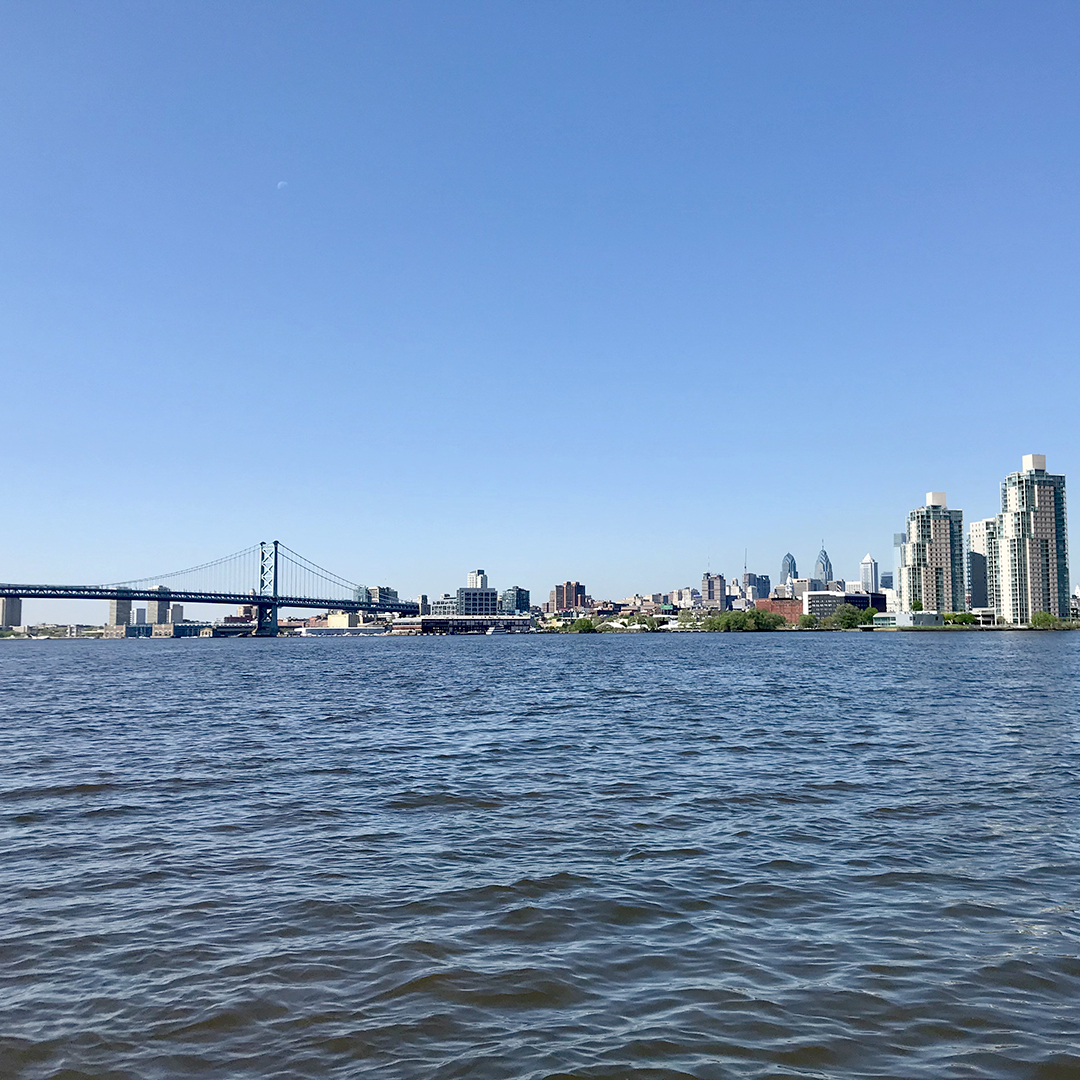 |
| The Delaware River and the Ben Franklin Bridge, Philadelphia, Pa. Photo by the DRBC. |
Historical Conditions
When the DRBC was created in 1961, little or no dissolved oxygen (DO) was present in the Delaware River Estuary from Wilmington to Philadelphia for periods of up to six months each year.
To combat this serious challenge, DRBC in 1967 established designated aquatic life uses and associated numerical water quality criteria necessary to protect those uses.
The aquatic life designated use in this part of the estuary was set as "maintenance" (survival) of resident fish and movement of migratory fish through these waters to and from spawning areas. The associated numerical criterion for dissolved oxygen was established at 3.5 mg/L.
Significant improvements in DO levels have occurred throughout this stretch of river since 1967, and today, dissolved oxygen levels in this section of the river routinely are above the criterion.
• Learn more about historic DO levels & recovery
• Learn more about DO and Nutrients
Conditions Today
Today, Delaware Estuary water quality is much improved. DO levels in the Delaware River Estuary are supportive of resident and migratory fish populations. There is also some degree of propagation (i.e., reproduction and juvenile development) occurring, which is further evidence of improved water quality.
Looking Ahead
We know that early life stages of estuarine fish species are generally more sensitive to DO levels than resident or migratory species. With evidence of propagation in this section of the estuary, the question is, can water quality be further improved to better support reproduction and juvenile development, especially that of sensitive species, for example, the endangered Atlantic sturgeon?
To answer this question, in 2017, the DRBC, with its state and federal co-regulators and others, began a multi-year effort that included monitoring, research, technical study, modeling and engineering analyses.
→ In September 2017, the DRBC unanimously approved Resolution 2017-4 recognizing the significant water quality improvements in the Delaware River Estuary that have occurred and affirming that continued improvement is an important goal.
- View Resolution 2017-4 (pdf)
- View Comment and Response Document regarding Resolution 2017-4 (pdf)
- View News Release
The Resolution directed staff to:
- Perform a study to determine the attainability of an improved aquatic life designated use of fish propagation in a 38-mile stretch of the Delaware River Estuary around Philadelphia, Camden & Wilmington
- Initiate a formal public rulemaking process on a proposed revised designated use and water quality criteria to protect that use and an implementation strategy
The Resolution provided for scientific and technical studies to be performed for the following purposes:
- To determine the DO requirements, as well as the spatial and temporal distribution of all life stages of important resident and migratory fish species that utilize the estuary;
- To develop and calibrate a 3D eutrophication model (linked hydrodynamic and water quality models) of the Delaware Estuary and Bay in close coordination with a panel of nationally recognized experts. The model will relate nutrient loads from point (end-of-pipe) and non-point (runoff) sources to DO targets, prepare scenarios to evaluate the attainability of various DO conditions and aquatic life uses and determine load and waste load allocations necessary to achieve attainable aquatic life uses.
- To evaluate the costs to achieve various levels of nutrient reductions through enhanced wastewater treatment.
- To perform technical and socioeconomic evaluations of upgrading designated aquatic life uses to include propagation in the portion of the estuary currently designated for fish maintenance only.
Study Area
A 38-mile stretch of the Delaware River Estuary, from Wilmington, Del. to just above the Tacony-Palmyra Bridge (connecting Phila. and N.J.).
It includes DRBC Water Quality Zones 3, 4, and the upper portion of Zone 5.
Study Partners
The DRBC is leading this groundbreaking effort through a collaborative process informed by:
- DRBC's Water Quality Advisory Committee, a group representing state and federal co-regulators, NGO's, academic institutions, municipal and industrial dischargers and water purveyors
- Expert Panel of Scientists and Engineers
- Representatives of DRBC's "co-regulators" - member state agencies and EPA Regions 2 and 3
- Representatives of point-source dischargers in the estuary (a total 67 provided data for this study)
Monitoring/Data Collection
To support these studies and the development of the eutrophication model, lots of monitoring was needed.
Ambient (surface water) nutrient monitoring, primary productivity and algal speciation studies were completed.
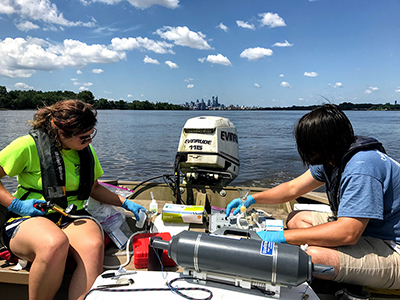 |
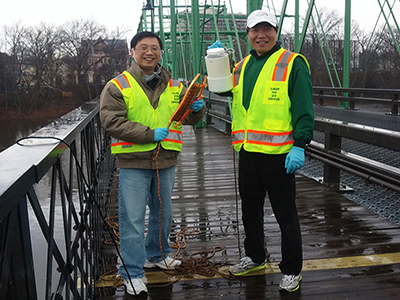 |
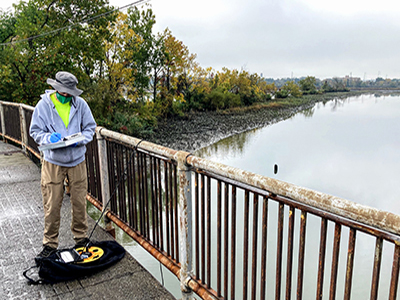 |
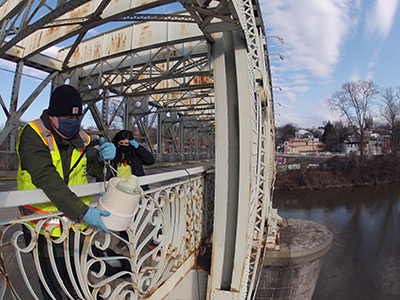 |
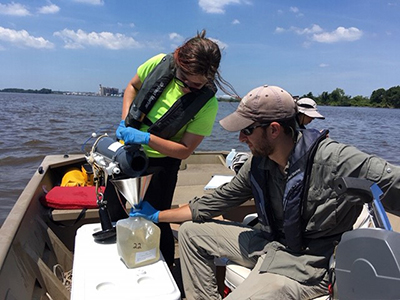 |
| Collecting water samples to look at light extinction data. |
Nutrient monitoring at the Calhoun St. Bridge (Delaware River). |
Nutrient monitoring at Darby Creek, a Delaware River tributary. |
Nutrient monitoring at the Falls Bridge (Schuylkill River). |
Collecting water samples to study primary productivity. |
Resolution for the Minutes September 2020
→ On September 10, 2020, at their 3Q Business Meeting, the Commissioners approved a Resolution for the Minutes that modified the schedule adopted in 2017 by Resolution 2017-4. The change to the schedule was necessary in light of COVID-19-related mitigation measures that affected monitoring efforts, as well as funding constraints.
Study Progress from 2017-2020
-
Input obtained from an Expert Panel on modeling the water quality impacts of nutrient loadings;
-
Research on the dissolved oxygen requirements of key sensitive species completed;
-
Ambient nutrient monitoring and primary productivity and algal speciation studies conducted to support model calibration;
-
Development of a hydrodynamic and eutrophication model;
-
Identification and evaluation of the capital and operating costs required for twelve wastewater treatment plants to implement technologies for achieving higher levels of dissolved oxygen; and
-
Evaluation of the physical, chemical, biological, social and economic factors affecting attainment of uses.
→ In April 2022, a group of NGOs sent a petition to the EPA seeking to bypass ongoing DRBC processes and compel EPA to commence a separate action to revise water quality standards for the protection of aquatic life in the Delaware River Estuary.
NGO Petition & EPA Response: April-May 2022
- View NGO Petition to the EPA (April 2022; pdf)
- View EPA response to the NGO Petition (May 2022; pdf)
DRBC Letter to EPA: October 2022
- View DRBC letter to the EPA (October 2022; pdf)
EPA Determination: December 2022
→ On December 1, 2022, EPA issued a determination that revising the water quality standards for a portion of the Delaware River Estuary is necessary to satisfy the requirements of the Clean Water Act. In doing so, EPA recognized the value of foundational science performed by the DRBC, including to demonstrate that propagation throughout the Estuary is attainable, and the commitment and ongoing work by DRBC and the Estuary states to update the standards.
- View EPA Administrator's Determination (December 2022; pdf)
- View EPA Response Letter to NGOs (December 2022; pdf)
DRBC Statement: December 2022
→ On December 1, 2022, the DRBC issued the following statement:
The Delaware River Basin Commission (DRBC) has received a copy of EPA's determination in response to a Petition filed by a group of non-governmental organizations. Staff is reviewing the EPA response with the Commission members and counsel.
The Petition sought to bypass ongoing DRBC processes and compel EPA to commence a separate action to revise water quality standards for the protection of aquatic life in a portion of the Delaware River Estuary. Because of the significant progress DRBC has already made – working in close collaboration with EPA and state co-regulators – to update the Estuary aquatic life use standards, the Commission viewed the Petition as unnecessary. (See DRBC letter to EPA, October 2022; pdf) Nevertheless, DRBC respects the Administrator's determination and welcomes EPA's continued engagement with DRBC in this effort.
EPA's response commends DRBC and its member state agencies for the significant water quality improvements realized in the Estuary. EPA also recognizes the value of foundational science performed by DRBC, including to demonstrate that propagation throughout the Estuary is attainable, and the commitment by DRBC and the Estuary states to update the standards. EPA acknowledges that the timeline for establishing new standards will be accelerated by the "readily available information that DRBC and other stakeholders have generated." The EPA also makes clear it, "acknowledges and appreciates DRBC's and your states' commitment to updating the WQS for the specified zones of the Delaware River Estuary."
Priority actions by the DRBC to revise the Estuary water quality standards to meet Clean Water Act goals are well underway. By resolutions adopted unanimously by the Commission's member states and the United States, the Commission has committed substantial resources over several years to establish the scientific foundation and conduct rulemaking for new standards through a transparent and collaborative process. The body of scientific work that DRBC has delivered supports the inclusion of fish propagation (by multiple species, including the endangered Atlantic Sturgeon) as a designated aquatic life use throughout the Estuary. DRBC-led science also has established the foundation for the development of new dissolved oxygen criteria to support this use. A summary of DRBC's plan for revising the Estuary water quality standards, along with key technical support documents and procedural records, are available on this webpage.
While EPA's decision has the potential to create a duplicative regulatory process, the DRBC is committed to continuing to work jointly with EPA and state co-regulator agencies in Delaware, New Jersey and Pennsylvania to develop water quality standards using sound science to meet the goals of the Clean Water Act and the Delaware River Basin Comprehensive Plan. The DRBC is equally committed to doing so through a transparent process that engages all concerned stakeholders. The Commission has a successful 61-year history of working collaboratively and delivering regulatory policy to protect and significantly improve water quality in the interstate waters of the Delaware River Estuary and is committed to continuing this critical work.
DRAFT Analysis of Attainability (AA) & Supporting Documents
- Analysis of Attainability: Improving Dissolved Oxygen and Aquatic Life Uses in the Delaware River Estuary (DRAFT; September 2022; pdf)
- Modeling Eutrophication Processes in the Delaware Estuary: Three-Dimensional Water Quality Model (DRAFT; September 2022; pdf) & Appendices A-H (DRAFT; September 2022; zip)
- Modeling Eutrophication Processes in the Delaware River Estuary: Three-Dimensional Hydrodynamics Model (DRAFT; December 2021) & Appendices A-N (DRAFT; December 2021; zip)
- Social and Economic Factors Affecting the Attainment of Aquatic Life Uses in the Delaware River Estuary (DRAFT; September 2022; pdf)
- Linking Aquatic Life Uses with Dissolved Oxygen Conditions in the Delaware River Estuary (DRAFT; November 2022; pdf)
- Nitrogen Reduction Cost Estimation Study: Final Summary Report (submitted to the DRBC by Kleinfelder, Inc.; January 2021; pdf)
The draft AA:
- Describes the results of studies performed with a state-of-the-art hydrodynamic and water quality model, showing the DO improvements to be achieved when ammonia effluent limits are reduced, and identifies the highest attainable dissolved oxygen condition, or HADO.
- Determines that DO levels are most impacted by summer ammonia loads from nine point sources (Philadelphia Water Department's Southwest, Southeast and Northeast wastewater treatment plants and the plants operated by Camden County Municipal Utilities Authority, City of Wilmington, Gloucester County Utilities Authority, Hamilton Township, DELCORA and Lower Bucks County Joint Municipal Authority).
- Summarizes the results of cost and affordability evaluations for reducing ammonia discharges to the Delaware River Estuary.
- Recommends steps for achieving the HADO.
- Recommends that the Commission initiate a rulemaking process, as outlined in Resolution No. 2017-4, to revise the designated aquatic life uses and develop water quality criteria to support those uses.
September 2023 Resolution Suspends DRBC Rulemaking
→ On September 7, 2023, the Commissioners approved a Resolution for the Minutes to support regulatory efficiency, intergovernmental coordination and clarity to the public in revising the aquatic life designated uses to provide for fish propagation and corresponding water quality criteria for dissolved oxygen in the Delaware River Estuary.
- View approved Resolution for the Minutes (pdf; 9/7/23)
In short, this Resolution for the Minutes suspended, effective immediately, Commission action to develop proposed regulations for public comment upgrading the designated aquatic life use for Water Quality Zones 3 and 4 and the upper portion of Zone 5 to include propagation. It withdrew the DRBC's scheduled commitment to adopt revised DRBC water quality standards for the Delaware River Estuary by March 2025. The USEPA will lead the rulemaking process.
The DRBC will continue to provide its scientific, technical and engineering assistance to support EPA's process for revising the aquatic life designated uses and corresponding criteria for Water Quality Zones 3 and 4 and the upper portion of Zone 5 of the Delaware River to meet the shared goal of updated water quality standards that improve protections for aquatic life. Staff will continue to coordinate and collaborate with state and federal co-regulators and basin stakeholders during EPA's rulemaking process.
DRBC Statement
- View Statement as pdf (September 7, 2023)
For over 60 years, the Delaware River Basin Commission (DRBC or Commission) has worked to protect and improve water quality throughout the Delaware River Basin. The DRBC supports the "fishable" goals of the Clean Water Act and has taken numerous priority actions to advance these goals in the Estuary, the tidal reach of the Delaware River. Most recently, the DRBC developed major science, engineering, and socioeconomic studies that lay a foundation for revised aquatic life water quality standards for the Estuary and rulemaking to adopt these standards. The Commission has consistently engaged stakeholders and the public on these issues through an open and transparent process.
The DRBC supports the adoption of revised water quality standards that protect fish propagation throughout the Estuary. By a Resolution for the Minutes dated September 7, 2023 (pdf), the Commission has deferred its planned rulemaking on new standards, pending completion of a separate, federal rulemaking announced by the U.S. Environmental Protection Agency on December 1, 2022 (pdf). The decision to defer DRBC rulemaking is being taken to support regulatory efficiency and intergovernmental coordination. DRBC's action will avoid concurrent notice and comment rulemaking processes to revise standards for the same water body. DRBC staff will continue to work closely with EPA and the Estuary state environmental protection agencies in Delaware, New Jersey and Pennsylvania to support vital water quality improvements.
The EPA is expected to propose a rule revising the designated uses and the water quality criteria required to protect those uses, in portions of the Estuary. The DRBC's scientists and engineers will continue to focus on strategies for implementing the new standards to achieve the measurable water quality improvements the standards are designed to support. The Commission's work will include identifying affected dischargers, developing wasteload allocations and effluent limitations, and considering capital improvement schedules and potential variances. The DRBC will conduct its work in close cooperation with the EPA and Estuary state co-regulators. Importantly, the DRBC will continue to engage stakeholders in the development of strategies, plans, analyses, and, if appropriate, regulations for the implementation of the new aquatic life uses and criteria, primarily through the Commission's long-standing Water Quality Advisory Committee.
The Commission will continue to support and provide resources to the EPA and the Estuary states to meet the shared goal of updated water quality standards that improve protections for aquatic life. The agencies will work together and with stakeholders to implement the improvements we collectively envision. A single, EPA-led rulemaking process will allow for focused engagement by Estuary communities, advocates and regulated entities.
Further questions about the EPA rulemaking process to revise the aquatic life water quality standards for the Delaware River Estuary should be directed to the EPA.
EPA Publishes Proposed Rule: December 2023
→ On December 14, 2023, the EPA published a proposed rule to revise the aquatic life designated use and dissolved oxygen water quality criteria applicable to Zone 3, Zone 4 and the upper portion of Zone 5 of the Delaware River Estuary.
- Click here for full information about the proposal, including how to comment (opens EPA website in new window)
- View news release issued by the EPA (December 14, 2023; opens in new window)
- Questions about the proposed rulemaking should be directed to the EPA (see above link)
The publication of this proposed rule represented a milestone in the effort to reach a fishable Delaware River, but is one step in an ongoing process to improve dissolved oxygen levels in the Delaware River Estuary.
The DRBC has been a part of the process leading up to this proposal and will continue to be involved, working with the EPA, our state environmental agencies and stakeholders to plan for the implementation of revised aquatic life use standards to improve water quality in the Delaware River Estuary. We encourage all stakeholders to learn about the proposed rule and engage in the public process.
EPA Public Hearings & Written Comments: February 2024
The EPA held two public hearings on this proposal on February 6 and 7, 2024. Written comments were due February 20, 2024.
→ At the February 6, 2024, public hearing, DRBC Executive Director Steve Tambini provided oral testimony for the record.
→ The DRBC submitted technical written comments for the record on Feb. 20.
→ In September 2024, the DRBC published A Pathway for Continued Restoration: Improving Dissolved Oxygen in the Delaware River Estuary and related modeling reports that support updating designated uses and associated water quality standards in the Delaware River Estuary to better support fish populations.
- View News Release (October 3, 2024)
- Stakeholder correspondence since the release of final reports:
- Comments from the Philadelphia Water Department (PWD) --
- PWD comments on EPA's proposed water quality standards (pdf; submitted February 2024; shared with DRBC in December 2024)
- PWD Letter to the DRBC (pdf; December 2024)
- DRBC's Response to PWD (pdf; June 2025)
- PWD comments on EPA's proposed water quality standards (pdf; submitted February 2024; shared with DRBC in December 2024)
- Comments from the Philadelphia Water Department (PWD) --
Download the Reports
- A Pathway for Continued Restoration: Improving Dissolved Oxygen in the Delaware River Estuary (pdf)
- Modeling Eutrophication Processes in the Delaware River Estuary: Three-Dimensional Hydrodynamic Model (pdf)
- Modeling Eutrophication Processes in the Delaware River Estuary: Three-Dimensional Water Quality Model (pdf)
- Appendices A-K (zip)
Delaware Riverkeeper Sues the EPA: October 2024
→ On October 2, 2024, the Delaware Riverkeeper Network (DRN) and Maya K. van Rossum, the Delaware Riverkeeper, sued the EPA in the United States District Court for the Eastern District of Pennsylvania over the timing of EPA's rulemaking. A notice of intent to sue preceded the complaint on Aug. 2, 2024.
→ The EPA answered DRN's complaint on December 9, 2024.
Proposed Consent Decree between EPA & DRN Issued for Public Comment: January 2025
→ On January 22, 2025, the EPA announced it had reached a tentative settlement of the litigation with DRN and released a proposed consent decree for public review and comment.
Under the terms of the proposed consent decree, the EPA Administrator would be required to sign a final rule promulgating revised water quality standards for the relevant Delaware River miles on or before June 30, 2025.
The EPA accepted public input on this proposed decree until February 20, 2025. Please direct all questions about this matter to the EPA.
- Click here for docket details (opens in new window)
- Click here to review the proposed decree and submit comment by Feb. 20, 2025 (opens in new window)
EPA Provides Update on its Process: April 2025
→ On April 1, 2025, the EPA issued a news release announcing its plans to finalize the proposed water quality standards.
In the news release, DRBC Executive Director Kristen Bowman Kavanagh was quoted: "EPA's rule, when finalized, will support improved conditions for aquatic life in the Delaware River Estuary, and I am proud of the Delaware River Basin Commission's (DRBC) sound scientific work in the process," said Kristen Bowman Kavanagh, P.E., DRBC's Executive Director. "The DRBC will continue to provide resources and expertise to our member states, EPA and stakeholders to implement the rule."
- View News Release (opens in new window)
- View EPA site for more information (opens in new window)
→ On July 14, 2025, EPA transmitted its draft final rule to the Office of Management and Budget (OMB) for interagency review. On July 15, 2025, the OMB updated its public-facing website to document receipt of EPA's rule package. Stakeholders can request a meeting with OMB via the website.
→ On July 21, 2025, the U.S. District Court for the Eastern District of Pennsylvania issued an order, which reflects EPA's and DRN's recent agreement on a stipulated judgment that requires EPA to sign a final rule on or before September 22, 2025. This order relates to the timing (not the substance) of EPA's final rule.
→ On September 22, 2025, the EPA announced a final rule establishing federal water quality standards for 38 miles of the Delaware River between Philadelphia, Pa., and Wilmington, Del.
This final rule will help improve water quality to protect sensitive aquatic species in the Delaware River, including the federally endangered Atlantic Sturgeon and Shortnose Sturgeon. The new standards issued by EPA establishes aquatic life protection and propagation as an achievable "designated use" with corresponding dissolved oxygen water quality criteria to protect this use in the Delaware River.
- View EPA News Release (opens in new window)
- View EPA site for additional info (opens in new window)
Quote from the DRBC:
"EPA's final water quality standards will provide a significant ecological boost to this section of the Delaware River," said Delaware River Basin Commission (DRBC) Executive Director Kristen Bowman Kavanagh, P.E. "The DRBC will continue delivering scientific and modeling expertise to EPA, our member states and stakeholders to aid in implementing the new rule and improving dissolved oxygen in our shared Delaware River."
→ In October 2025, DRBC published "A Strategy to Implement New Dissolved Oxygen Criteria in the Delaware River Estuary." This document outlines a technical approach that the DRBC, EPA and the Estuary states can use, specifically, a wasteload allocation study to be performed by the DRBC that will provide a basis for the states to derive and impose valid numerical effluent limitations. DRBC scientists will continue to work in close cooperation with the EPA and the Estuary co-regulating states (Pa., N.J. and Del.) to support EPA's new DO criteria.
- A Pathway for Continued Restoration: Improving Dissolved Oxygen in the Delaware River Estuary (pdf; September 2024)
- Modeling Eutrophication Processes in the Delaware River Estuary: Three-Dimensional Hydrodynamic Model (pdf; August 2024)
- Modeling Eutrophication Processes in the Delaware River Estuary: Three-Dimensional Water Quality Model (pdf; August 2024)
- Appendices A-K (zip; August 2024)
- Appendices A-K (zip; August 2024)
- Nitrogen Reduction Cost Estimation Study: Final Summary Report (pdf; this report was submitted to the DRBC by Kleinfelder, Inc., in January 2021)
- Report to DRBC on Concentrations of Nutrients and Chlorophyll-a and Rates of Respiration and Primary Production in Samples from the Delaware River Collected in May and July 2019 (pdf; this report was submitted to the DRBC by the Horn Point Laboratory, University of Maryland; revised Sept. 2020)
- Report to DRBC on Concentrations of Nutrients and Chlorophyll-a and Rates of Respiration and Primary Production in Samples from the Delaware River Collected in May and July 2018 (pdf; this report was submitted to the DRBC by the Horn Point Laboratory, University of Maryland; revised Feb. 2019)
- A Review of Dissolved Oxygen Requirements for Key Sensitive Species in the Delaware Estuary (pdf; this report was submitted to the DRBC by the Academy of Natural Sciences in November 2018)
- A Methodology for Evaluating Dissolved Oxygen Requirements of Species in the Delaware Estuary (pdf; this report was submitted to the DRBC by the Academy of Natural Sciences in March 2018)
- Existing Use Evaluation for Zones 3, 4, & 5 of the Delaware Estuary Based on Spawning and Rearing of Resident and Anadromous Fishes (pdf; September 2015)
- Report to DRBC on Concentrations of Nutrients and Chlorophyll-a and Rates of Respiration and Primary Production in Samples from Delaware Bay Collected in May and July 2014 (pdf; this report was submitted to the DRBC by the Horn Point Laboratory, University of Maryland in May 2015; revised Jan. 2019)
- A Strategy to Implement New Dissolved Oxygen Criteria in the Delaware River Estuary (pdf; given at the December 2025 Water Quality Advisory Committee Meeting)
- Historical Assessment of Estuary using EPA's New Dissolved Oxygen Criteria (pdf; given at the December 2025 Water Quality Advisory Committee Meeting)
- Estuary Dissolved Oxygen Model Enhancements (pdf; given at the December 2025 Water Quality Advisory Committee Meeting)
- The Delaware River Basin Commission: Its History & Current Issues (pdf; given at Oct. 2025 NJWEA Fall Technology Seminar; includes section on a Restoration Pathway to Improve DO )
- Improving Dissolved Oxygen in the Delaware River Estuary: Moving from a Pathway to Implementation (pdf; given at the February 2025 PDE Science Summit)
- Use of Change Factor Methodology to Estimate Dissolved Oxygen Under Various Loading Conditions (pdf; given at the February 2025 PDE Science Summit)
- Understanding Sediment Oxygen Demand in the Delaware River Estuary Impacts, Insights and Uncertainties (pdf; given at the February 2025 PDE Science Summit)
- Update on the Aquatic Life Designated Use Rulemaking (pdf; given at the April 2024 Water Quality Advisory Committee Meeting)
- Improving Dissolved Oxygen and Aquatic Life Uses in the Delaware River Estuary (pdf; given at the NJ-AWRA Watershed Leadership Forum, March 2023)
View a video of the presentation, courtesy of the NJ-AWRA:
- Status of WQS-ALU Co-Regulator Workgroup (pdf; given to the Water Quality Advisory Committee, March 2023)
- Status of the DRBC Draft AA Reports (pdf; given to the Water Quality Advisory Committee, March 2023)
- Improving Dissolved Oxygen and Aquatic Life Uses in the Delaware River Estuary (as part of the Delaware Estuary Science & Environmental Summit, DRBC staff gave seven presentations and two posters on this topic, January 2023)
- Review of Aquatic Life Uses: Progress Update (pdf; given to the Water Quality Advisory Committee, November 2022)
- Analysis of Attainability (AA) Preview (pdf; given to the Water Quality Advisory Committee, September 2022)
- Analysis of Attainability (AA) Progress Update (pdf; given to the Water Quality Advisory Committee, August 2022)
- Analysis of Attainability (AA) Progress Update (pdf; given to the Water Quality Advisory Committee, July 2022)
- Point Discharge Monitoring Results and Summary (pdf; given to the Water Quality Advisory Committee, June 2022)
- Analysis of Attainability (AA) Progress Update (pdf; given to the Water Quality Advisory Committee, June 2022)
- DO Relative Stress Index: Comparison Tool for Different Model Scenarios (pdf; given to the Water Quality Advisory Committee, June 2022)
- Analysis of Attainability: Methodology Discussion (pdf; given to the Water Quality Advisory Committee, May 2022)
- Status Update on DRBC's Socio Economic Evaluation (pdf; given to the Water Quality Advisory Committee, May 2022)
- Estuary Eutrophication Model: Final Calibration Results and Intro to Analysis of Attainability Elements (pdf; given to the Water Quality Advisory Committee, April 2022)
- Status Update: Aquatic Life Designated Use Program (pdf; given to the Water Quality Advisory Committee, Nov. 2021)
-
DRBC Expert Panel Update for the Water Quality Advisory Committee (pdf; given to the Water Quality Advisory Committee, Nov. 2021)
- Application of Eutrophication Modeling to Understand the Potential to Expand Designated Aquatic Life Uses in the Delaware River Estuary (pdf; given at the AWRA Mid-Atlantic Conference, Oct. 2021)
- Designated Use for Aquatic Life in Delaware River (pdf; given at the ICWP Annual Meeting; Oct. 2021)
- Restoring Water Quality in the Main Stem Delaware River: Programs, Policies and Strategies (pdf: given by DRBC staff at the 9th Annual Delaware River Watershed Forum, Sept. 2021)
- Socio Economic Evaluation in Support of Highest Attainable Designated Use (pdf; given to the Water Quality Advisory Committee, April 2021)
- Analysis of Attainability Part I: A Strategy to Determine Potential Designated Uses in the Delaware Estuary (pdf; given at the PDE Science and Environmental Summit, March 2021)
- Analysis of Attainability Part II: Linking Aquatic Life Uses with Dissolved Oxygen Condition in the Delaware River Estuary (pdf; given at the PDE Science and Environmental Summit, March 2021)
- DRBC Resolution for the Minutes: Sept. 2020 - Revised Schedule for Aquatic Life Designated Use Project (pdf; given at the joint WQAC/Expert Panel Meeting, Oct. 2020)
- Expert Panel Report to DRBC's WQAC (pdf; given at the joint WQAC/Expert Panel Meeting, Oct. 2020)
- Studies to Determine the Attainability of Aquatic Life Uses and Associated DO Conditions in the Urbanized Portion of the Delaware Estuary (pdf; given at the Delaware Watershed Research Conference, Oct. 2020)
- A Fishable, Swimmable (and Drinkable) Delaware River Estuary (pdf; given at the 8th Annual Delaware River Watershed Forum, Sept. 2020)
- Status Update: Aquatic Life Designated Use Program (pdf; given to the WQAC on 7/28/20)
- Nutrient Monitoring 2020 (pdf; given to the MACC on 5/12/20)
- "Analysis of Attainability": A Strategy to Determine Highest Attainable Dissolved Oxygen Condition (pdf; given to the WQAC on 4/30/20)
- Eutrophication Model Development Monitoring (pdf; given to the MACC on 12/18/19)
- Meeting of the Model Expert Panel with DRBC Staff (pdf; given to the WQAC on 12/5/19)
- Update given at the WQAC Meeting, November 2019 (pdf)
- Update on Engineering Evaluation and Cost Estimates Contracted Work (pdf; given at the Delaware Watershed Research Conference, November 2019)
- Modeling Eutrophication Processes in the Delaware Estuary to Link Watershed Efforts to Control Nutrient Impacts (pdf; given at the Delaware Watershed Research Conference, November 2019)
- Eutrophication Model Development Monitoring Updates 2019 (pdf; given to the MACC on 6/17/19)
- Tributary Ultimate BOD Monitoring (pdf; given to the MACC on 6/17/19)
- Other DRBC Monitoring Surveys (pdf; given to the MACC on 6/17/19; see light extinction and primary productivity slides)
- Update on Eutrophication Model Development (pdf; given to the WQAC on 5/14/19)
- Additional Review of Existing DO Data (pdf; given to the WQAC on 5/14/19)
- Meeting of the Model Expert Panel with DRBC Staff - A Report to the WQAC (pdf; given to the WQAC on 3/20/19)
- The Next Chapter in the Story of Restoring Clean Water to the Delaware River Estuary (pdf; given at the AWRA Annual Conference, November 2018)
- Dissolved Oxygen, Aquatic Life Uses, and the Delaware Estuary (pdf; given at the WRADRB Annual Fall Conference, November 2018)
- Updating Major Wastewater Treatment Infrastructure for Delaware Estuary Aquatic Life Uses: Technical, Economic, and Social Impacts (pdf; given at the Delaware Watershed Research Conference, November 2018)
- Modeling Eutrophication Processes in the Delaware Estuary to Link Watershed Efforts to Control Nutrient Impacts (pdf; given at the Delaware Watershed Research Conference, November 2018)
- Eutrophication Model Development Monitoring 2018 (pdf; given at the March 29, 2018, WQAC Meeting)
- Additional Monitoring Evaluation for Delaware Estuary Point Discharges (pdf; given at the August 2017 WQAC Meeting)
- DRBC to Review Aquatic Life Uses in Delaware River Estuary in Recognition of Improved Water Quality (pdf; given at the April 7, 2017, public hearing)
During public meetings from 2010 through 2023, the Commission adopted the numbered resolutions (subject to public hearing) and resolutions for the Minutes (not requiring public hearing) listed in chronological order below, results of which were used to support various aspects of the Aquatic Life Designated Use Study.
All are pdfs.
- Resolution No. 2010-5: Nutrient monitoring of point source discharges to the Estuary and Bay
- Resolution No. 2012-7: Formation of Model Expert Panel
- Resolution No. 2013-6: Analysis of primary productivity by University of Maryland
- Resolution No. 2014-9: Study of effects of low DO and the presence of PCBs on the early life stages of the Atlantic sturgeon
- Resolution for the Minutes of March 15, 2017: Consultation services for model development from LimnoTech
- Resolution No. 2017-4: Initiates the Aquatic Life Designated Use Study
- Resolution No. 2017-5: Analysis of primary productivity by University of Maryland
- Resolution for the Minutes of Sept. 13, 2017: Monitoring of effluent from Estuary point source discharges for two years
- Resolution No. 2018-6: Feasibility and cost evaluation of effluent ammonia reduction from key point source dischargers by Kleinfelder
- Resolution for the Minutes of June 12, 2019: Consultation services for enhancement of source code for the hydrodynamic model (EFDC) from GHD
- Resolution for the Minutes of Dec. 11, 2019: Analytical services for algal composition from Academy of Natural Sciences, Drexel University
- Resolution for the Minutes of Sept. 10, 2020: Revision of project period due to COVID 19 and budget constraints
- Resolution 2021-5: Collection of additional information essential to the evaluation of social and economic factors
- Resolution for the Minutes of March 9, 2022: Authorizing agreement for professional services with the Environmental Finance Center at the University of Maryland
- Resolution for the Minutes of September 7, 2023: To support regulatory efficiency, intergovernmental coordination and clarity to the public in revising the aquatic life designated uses to provide for fish propagation and corresponding water quality criteria for dissolved oxygen in the Delaware River Estuary
- Resolution for the Minutes of December 10, 2025: Authorizes and directs the Executive Director, in consultation with the Estuary states and the U.S. Environmental Protection Agency ("EPA"), to develop a wasteload allocation ("WLA") study to assist the Estuary states in attaining the dissolved oxygen ("DO") criteria promulgated by EPA on September 29, 2025, in the tidal Delaware River.
Copyright © Delaware River Basin Commission,
P.O. Box 7360, West Trenton, NJ 08628-0360
Phone (609)883-9500; Fax (609)883-9522
Thanks to NJ for hosting the DRBC website